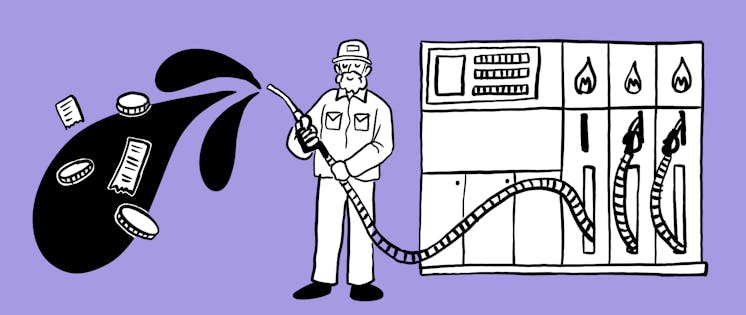
HMRC mileage rates for 2024: The cost of going the extra mile
Hot take: You’re paying too much in tax because no one told you about the government schemes that you should be taking advantage of.
We want to help your employees keep more of their salary, and help your business keep more of its revenue.
How? The mileage allowance.
Mileage claim rates are a great way for companies to help their employees reduce tax bills. For those of us blessed with company cars, there are still tax-efficient savings to be made through HMRC fuel rates.
The thing is, it takes a bit of admin on the finance side of things. Not only will you have to claim business travel for tax-efficient savings, but also keep track of the numbers and reimburse employees as you go.
Want to learn more about claiming business travel expenses? Let us show you how it works.
Content Overview
What is HMRC's mileage allowance?
The car allowance mileage rates enable employees to claim back vehicle expenses when they are driven for the purpose of the business. In theory, this rebate goes beyond the cost of petrol – towards covering road tax, insurance and weathering for example. But calculating the individual tyre wear and tear on every single vehicle is simply unrealistic, especially for growing teams.
HMRC works with standardised pence per mile expenses instead, known as ‘Mileage Allowance Payments’ (MAPs). This business mileage deduction applies to any employee that operates their vehicle for business use.
The purpose of the reimbursement is to align with current business tax regulations.
Generally, business costs are not subject to tax, and are able to be deducted against revenue to ensure you’re not paying too much tax. When business-related vehicle expenses are incurred from a personal account, therefore, the mileage allowance ensures that they are also tax-exempt.
What is the mileage rate for 2024 in UK?
The business mileage rate for 2024 is set by HMRC and isn’t going to change compared to previous years. The difference depends on the type of vehicles employees use.
Type of Vehicle | 10,000 miles | 10,000 + miles |
|---|---|---|
Cars and vans | 45p | 25p |
Motorcycles | 24p | 24p |
Bikes | 20p | 20p |
Let’s break each one down individually.
Cars and vans mileage rate
HMRC-approved mileage rate for cars and vans is set at £0.45 per mile when driven under 10,000 miles per year. If the vehicle is used for more, the employee receives £0.25 per mile above that 10,000 threshold.
Let’s say that in the last year, you’ve driven 16,000 miles for work purposes. Those first 10,000 miles mean you’re eligible to receive 45p per mile:
£0.45 x 10,000 = £4,500
Then, you drove 6,000 extra miles which means you’re eligible to receive 25p per mile:
£0.25 x 6,000 = £1,500.
Therefore, your reimbursement will total £6,000.
The government advises that you consider hybrid cars as standard for mileage rate purposes, with the same standard rates.
Electric car mileage rates sit at £0.05 per mile since electricity is not considered fuel by HMRC. Importantly, there is no limit so even after 10,000 miles per year are driven, the rate remains consistent.
Motorcycles mileage rate
If your employee drives a motorcycle, they’re eligible to receive £0.24 per mile when driving for business purposes. Unlike cars and vans, motorcycles are not subjected to the 10,000 miles limit, which means that going above this threshold does not change the 24p rate.
Let’s say you’ve driven 2000 miles for work this year on your motorbike:
£0.24 x 2000 = £480 in tax-free reimbursement.
Bicycles mileage rate
Those who ride bicycles to work might not be paying for fuel, but still incur costs such as insurance, as well as general wear and tear during use. The government recognises this and awards £0.20 per mile for an unlimited amount of business-related mileage.
So, let’s say you’ve cycled 300 miles for eligible business trips this year:
£0.20 x 300 = £60 to receive tax-free reimbursement.
Plus, riding a bike to work is not only a great way to improve your physical and mental health, but also the health of the planet. Nice.
Do you work for a health trust?
You could be eligible for more.
The rate of 56p per mile will remain the same for the first 3,500 miles in a year, but then increases from 20p to 30p for any miles thereafter. It means that those who are travelling most frequently for work will see a 10p increase in their mileage reimbursement.
Car-related travel for work by nurses, care workers and those involved with the Agenda for Change are eligible for these changes. These changes are being brought in specifically by the health department.
What can be reimbursed by mileage allowance?
So, what does HMRC mileage allowance cover exactly? Only certain actions are actually deemed valid business expense activities.
Here are some examples of trips that CAN be reimbursed by mileage allowance:
- Travelling somewhere outside of the usual office space to do your job
- Travelling between office spaces
- Driving to client offices
- Driving to a temporary location (such as a conference) to conduct business
- A job cannot be done without the trip being made (i.e. if a colleague has broken down on the way to work and has to be picked up by another colleague)
Here are some examples of things that CAN NOT be reimbursed by mileage allowance:
- The daily commute to a permanent office
- A trip that is extremely close (while there isn’t an official HMRC definition, the generally-accepted distance is 10 miles).
- A trip that is primarily personal with a minority of work-related stops
- Toll payments or parking tickets
Remember, this list is not exhaustive. If in doubt, take a look at HMRC’s website.
How are mileage tax rates calculated?
Each employee is eligible for an approved amount of mileage expenses reimbursement per tax year, calculated by the number of miles driven (the MAP).
Since most businesses operate by reimbursing employees on a monthly basis, companies are required to keep track of total mileage over the course of the tax year. In the end, the company must compare the actual amount paid to the MAP. If the employee receives any amount above the allowance, it may then be subject to tax.
Once you’ve used a mileage calculator, HMRC does not require any information or reporting as long as you do not go over the approved MAP amount.
Tax relief claims per qualifying passenger
Did you know that drivers who carry their colleagues as passengers are entitled to a further mileage allowance? Though it’s not a company car, mileage rates increase by £0.05 per mile when a fellow employee is also travelling for business purposes within the same vehicle.
For example, let’s say Jane drives her colleague Andy for 60 business miles per month. Over twelve months, this totals to 720 miles per year:
£0.05 x 7200 = £36 extra that Jane is eligible to receive tax-free.
The passenger part of this MAP scheme also falls under the approved amount and does not require additional reporting to HMRC.
Carpool, anyone?
HMRC advisory fuel rates 2024
As it happens, the mileage allowance only applies to employee-owned vehicles, with cars owned by the company under totally different regulations. Known as HMRC advisory fuel rates, the company car category is used for two very specific circumstances:
1. When employees require reimbursement for costs relating to business travel in a company car (such as paying for fuel on their personal credit card)
2. When employees have used the company car for personal travel and owe the business
Company car fuel rates are slightly more difficult to calculate than standard HMRC mileage allowances and are reviewed every three months. They depend on actual fuel rates (which are particularly volatile now), so are likely to change as this year progresses. Businesses can only rely on the previous rates for up to one month before switching to current rates.
As you can see, HMRC fuel rates are calculated with a number of factors in mind, such as:
- Engine size
- Mean and adjusted miles per gallon (determined from manufacturer information)
- Current fuel prices
- Calculated and rounded (actual) rate per mile
Similar to the mileage allowance, hybrid cars are considered to be the same as petrol and diesel cars. However, fully electric vehicles are reimbursed at £0.09 per mile.
The following tables were taken from HMRC and are applicable from 1 December 2023. They're provided with the purpose of breaking down exactly why fuel rates are at their current numbers:
Petrol
Engine size (cc) | Mean MPG | Fuel price (per litre) | Fuel price (per gallon) | Rate per mile | Advisory fuel rate |
|---|---|---|---|---|---|
Up to 1400 | 49.5 | 152.4 pence | 692.8 pence | 14.0 pence | 14 pence |
1401 to 2000 | 42.1 | 152.4 pence | 692.8 pence | 16.5 pence | 16 pence |
Over 2000 | 26.7 | 152.4 pence | 692.8 pence | 26.0 pence | 26 pence |
Diesel
Engine size (cc) | Mean MPG | Fuel price (per litre) | Fuel price (per gallon) | Rate per mile | Advisory fuel rate |
|---|---|---|---|---|---|
Up to 1600 | 56.7 | 160.4 pence | 729.1 pence | 12.9 pence | 13 pence |
1601 to 2000 | 48.0 | 160.4 pence | 729.1 pence | 15.2 pence | 15 pence |
Over 2000 | 36.3 | 160.4 pence | 729.1 pence | 20.1 pence | 20 pence |
LPG (Liquefied Petroleum Gas)
Engine size (cc) | Mean MPG | Fuel price (per litre) | Fuel price (per gallon) | Rate per mile | Advisory fuel rate |
|---|---|---|---|---|---|
Up to 1400 | 39.6 | 86.7 pence | 394.1 pence | 10 pence | 10 pence |
1401 to 2000 | 33.7 | 86.7 pence | 394.1 pence | 11.7 pence | 12 pence |
Over 2000 | 21.3 | 86.7 pence | 394.1 pence | 18.5 pence | 18 pence |
In reality, what matters is only the size of the vehicle’s engine and its equivalent price per mile. Let’s go through an example where your business owns a company car.
The car has a 1000cc petrol engine and is driven by employees who pay for fuel for 2000 miles per year. However, the same employee uses the company car for personal use for 500 miles per year.
The advisory fuel rate (from December 2023) for petrol cars with engines up to 1400cc is £0.14 per mile.
14p x 2000 miles = £280.
14p x 500 miles = £70.
Therefore, £280 is the total amount you can claim from HMRC through the fuel advisory for 2024. But your company is also eligible to recoup £70 from the employee.
Questions? We got you
Can I use a different mileage allowance than the standard in 2024?
Yes, sometimes it’s helpful for businesses to set a rate that is higher or lower than the government mileage rate.
In the case of a higher rate, any amount above the MAP is eligible for tax. In the case of a lower rate, the employees are still eligible for tax relief but must claim it themselves.
For example, let’s say Martin’s company reimburses £0.20 per mile and he drives 300 business miles per year. He would receive just £60, while the MAP is £135. This makes Martin eligible to claim an extra £75 in tax relief from the government.
How do I claim mileage back from HMRC?
After using HMRC mileage claim calculator, you may have realised that your company provides a lower rate than the MAP allows.
In order to claim the rest of your tax relief, ensure you keep records and calculate the exact difference between the expected and actual totals. A good way to do this is to use a mileage tracker.
Claims under £2,500 can be made using the P87 HMRC form. Alternatively, claims over this amount will have to be made through self-assessment.
If you’re self-employed, claiming mileage on taxes in 2024 doesn’t have to be complicated. The same rules apply, with HMRC advisory fuel rates appropriate if you founded a corporation and the car is not owned personally.
How do I best reimburse my employees in 2024?
With the mileage allowance being pence per mile expenses, it can become incredibly tedious to manually track and calculate the individual mileage allowance per employee. Plus, SMEs with company cars have mileage reimbursements to consider. Talk about time better spent on actually growing the business!
Fortunately, software makes it simple. Pleo’s Reimbursements feature calculates the exact mileage for every journey based on start and end data, and automatically works with HMRC figures to calculate the mileage tax relief on each journey. Riddled with regulatory features, it’s easy to see why business fuel cards are the choice of companies across the country.
And if you are not ready for a software solution just yet, then our mileage reimbursement template might come in handy for you.

Smarter spending for your business
Save time on tedious admin and make smarter business decisions for the future. Join Pleo today.
Powered in the UK by B4B partnership
You might enjoy...

What businesses need to know about HMRC fuel rates for private cars in 2024
Businesses can offset fuel expenses for work-related journeys, but what about if you’re not driving a company car… can the fuel rates still...

Just the ticket: How our customers travel with Pleo
Planes, trains, automobiles and ferries – all the ways to travel for business with Pleo.

These tools make business travel feel like plain sailing
Business travel is back! Whether you love it or hate it, these apps and tools take the stress away.
